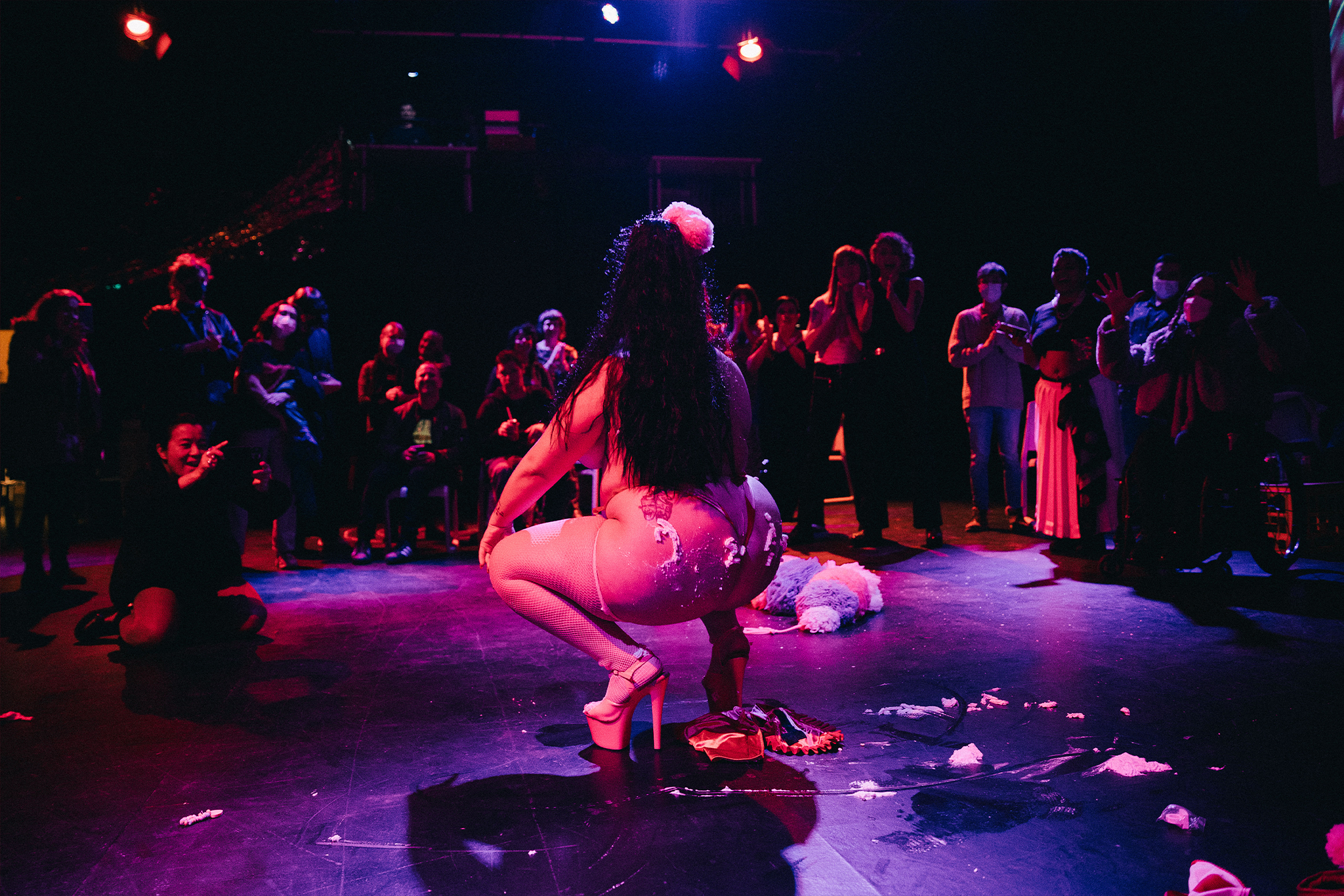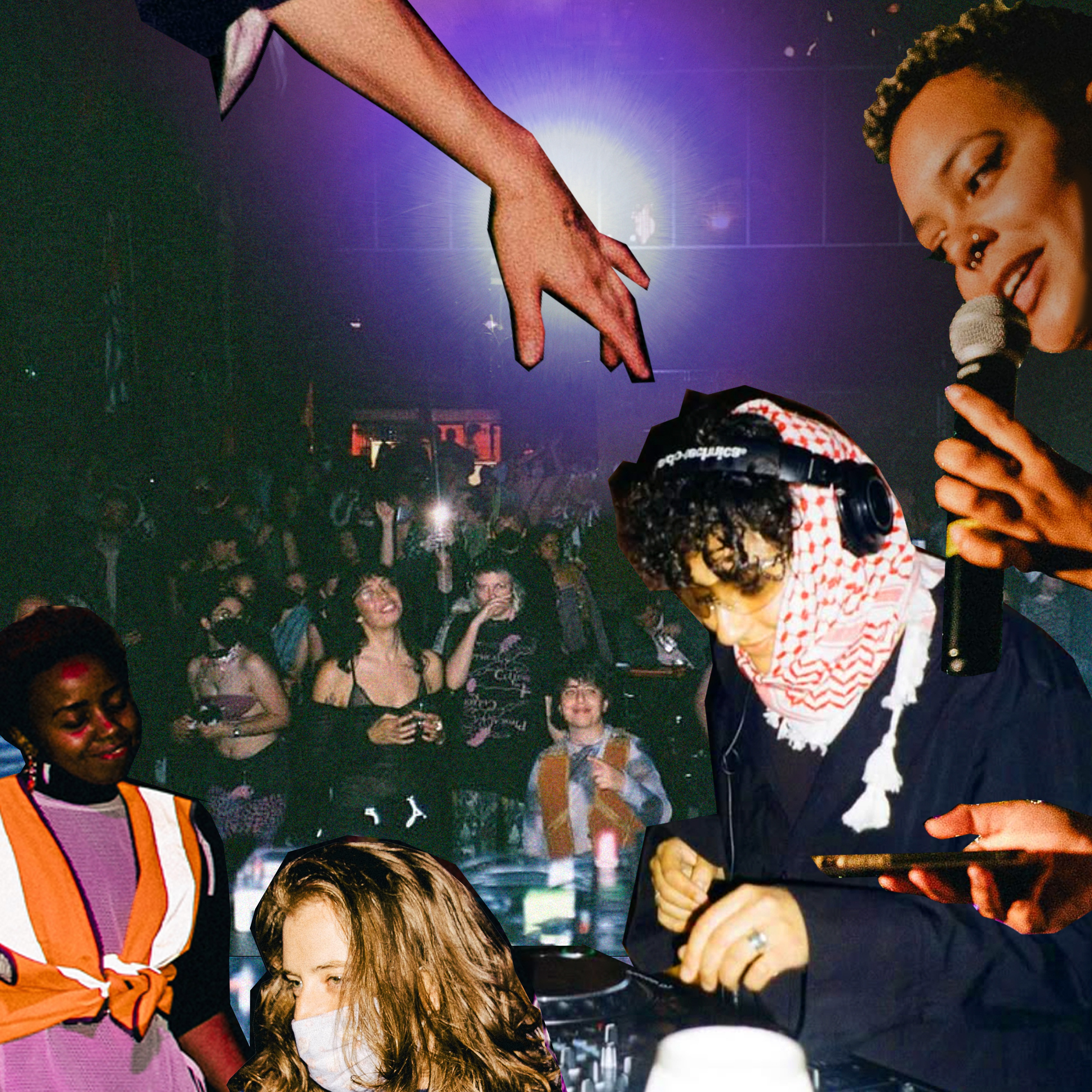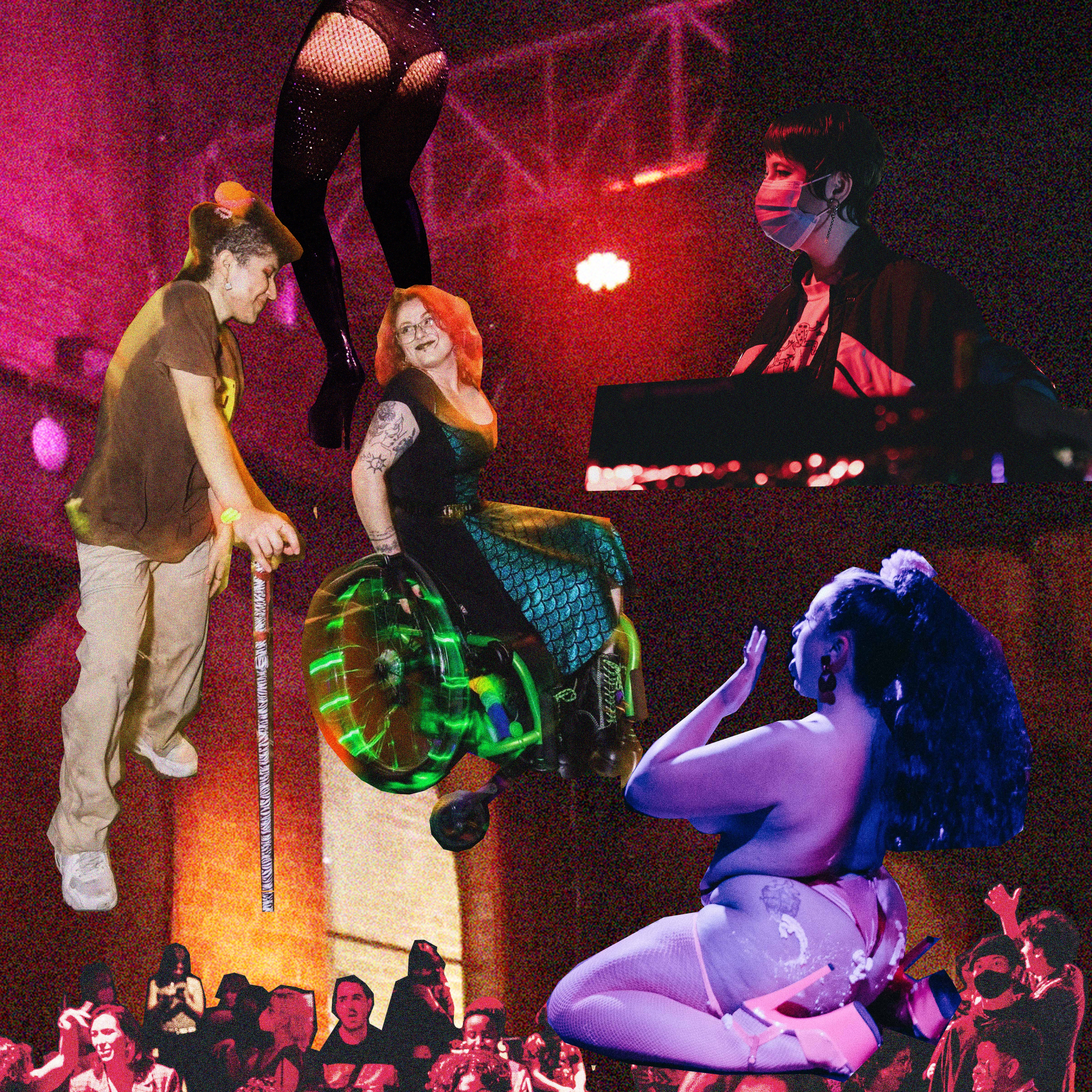 INTERVIEWS
INTERVIEWS
CRIP RAVE THEORY: Expanding sound & club culture
Ahead of CRIP RAVE THEORY's return to Gadigal Land/Sydney this weekend, founder Riana Head-Toussaint shared what makes it an event unlike any other.
‘Accessibility’ in music, clubbing and nightlife is a word becoming increasingly relevant to all audiences, not just those who are living with disability.
Accessibility is at its core, after all, a way to ensure that every member of a crowd, every artist, every fan and passionate person is able to engage and enjoy what a space has to offer. It’s a means of ensuring that on the dance floor, we all really have equal opportunity.
CRIP RAVE THEORY is a project with this mantra at its core, drawing on ‘intersectional disabled/crip knowledge’ to expand club and sound culture. Its founder Aquenta, real name Riana Head-Toussaint, is an interdisciplinary disabled/crip artist, who uses a manual wheelchair for mobility. Riana’s lived experience led to the creation of CRIP RAVE THEORY, a response to persistently inaccessible spaces, designed to celebrate all bodies traditionally excluded from commercial nightlife; with a focus on inter-community solidarity, pleasure, self-expression, agency and creative expansion.
CRT has hosted a range of some of the biggest local and internationally recognised disabled, bla(c)k, poc, queer and trans DJs, musicians and performers, including Aisha Mirza, BAE BAE, Lubly Day Crew, Lakatoi, halalbutch, Demon Derriere and many more.
This weekend, CRIP RAVE THEORY returns to Gadigal Land/Sydney once again.
Ahead of the event, Mixmag ANZ spoke with CRT head Aquenta all about what makes the event unlike any other.

Q: Why did you first start Crip Rave Theory?
RI: On a practical level, I started it because as a wheelchair-user, the reality was that I couldn’t attend 99% of the clubs and live music events/venues in my city that I wanted to (and pretty much still can’t!). They were always in basements with stairs, or old pubs, or places without accessible toilets, etc. Having a night out was either impossible, or really complicated, and would usually end up making me feel othered – like I wasn’t supposed to be there.
Plus I was DJing and I wanted to play gigs! Even on the rare occasions that I could get into clubs, the DJ booths were never accessible.
I wanted to change that. I wanted to create a club and music space where disabled people – both artists and audienecs – would feel genuinely welcomed, witnessed and celebrated, and I hoped that I had the skills and connections to do that.
Q: What’s one thing that you really wish people would understand about CRIP RAVE THEORY?
RI: CRIP RAVE THEORY is not just for disabled people!
It is disability-led and informed, AND it aims to be a more accessible space for all people who are marginalised or excluded from traditional party/nightlife spaces, AND it is for everyone! These things are not mutually exclusive, even though history and present-day society continue to try to convince everyone that they are.
Q: What’s one important nuance in the way CRIP RAVE THEORY approaches disability in music/clubbing culture that you feel is often missed or overlooked?
RI: I think one of the really important things about CRIP RAVE THEORY is that we move from the place that music and club culture needs disabled people – as artists, audiences and organisers.
It might seem strange to have to state that – especially when you consider that across time, some of the most innovative and celebrated people in and around music have been disabled. However, despite this, disability has been and still is usually positioned as something that people that have to ‘overcome’, or succeed ‘in spite of’; instead of an integral part of who they are, their craft, and their creativity in how they engage with, program and receive music.
At CRIP RAVE THEORY, we know this, and it informs everything that we do.
Q: Can you tell us about the word ‘crip’ in the name?
RI: ‘Crip’ is a term that is derived from the slur cr*pple, which was historically used against disabled people. Just like the word ‘queer’, the word Crip has now been reclaimed by the disabled community, as a unifying and defiant pride term.
When I created CRIP RAVE THEORY, I felt it was really important to include this term in the name. It speaks to disability history and culture; our resilience, and also the event’s politics. We are about pushing against outdated perspectives, binaries and silos – solidarity not charity, no Inspiration Porn, no ableism, no paternalism!
CRIP RAVE THEORY is rooted in the principles of Disability Justice; a concept that was initially conceived of by queer, disabled women of colour, Patty Berne, Mia Mingus, and Stacey Milbern. All three were a part of Sins Invalid, a group which defines Disability Justice through ten key principles: intersectionality, leadership by those most affected, anti-capitalism, solidarity across different activist causes and movements, recognising people as whole people, sustainability, solidarity across different disabilities, interdependence, collective access, and collective liberation. I would encourage everyone to read more about this!
Q: Can you talk to us more about ‘intersectional accessibility’, and why that’s part of your approach to access?
RI: Often, disability is a part of people’s identities that gets siloed off from all the other aspects of their personhood. However, as Audre Lorde said, we do not live single-issue lives. Disabled people are also black people, trans people, queer people, mob. And as Disability Justice emphasises, disabled people who also cross these other intersections are some of the most impacted by ableism, racism, transphobia etc, because these systems of oppression all interact and reinforce each other. This happens in all spaces, including music and nightlife.
In line with this reality, it is really important that CRT is led and informed by those of us who live this, and also, that we think about access in an intersectional way. This is why, in addition to the more typical access services that you might associate with disability, we always have a Welcome to Country at our events, why we book majority disabled, queer and/or trans people of colour for our lineups, why we have all-gender bathrooms, why we do lots of community outreach in the leadup, etc. We are trying to recognise the fullness of the experiences of all the people who enter our space, and cater to their realities.
Q: How do you feel that CRT fits into the broader dance music / clubbing landscape?
RI: I think CRT is really unique and fills a huge gap in our broader dance music/clubbing landscape… it’s one of the only ongoing, unsegregated, disability-led and openly disability-proud dance music/clubbing events in so-called Australia that I know of at the moment!
From what I’ve heard from punters – both those who do and don’t identify as disabled – the experience of attending CRT is often unlike anything they’ve ever experienced before. People often say they feel really relaxed and free in the space. I think the intersectional way we approach access is a big part of this.
I think it’s really different culturally to a lot of other events out there because it celebrates disability, but not in a way that separates it from the other aspects of people’s personhoods. It tries to say, as much as possible, ‘all of you are welcome here’ – and I don’t feel like a lot of other events do that. Often, either explicitly or implicitly, a lot of dance music/clubbing events are about getting you to focus on one thing – one style of music, one community, one part of yourself. That’s the opposite of what CRT tries to do. As disabled people we experience so much forced segregation across all aspects of our lives, so it’s not something we’re trying to engage in at all.
And then on a more basic level, I think we just offer really different lineups to a lot of other events. We are always trying to challenge cultural norms around who can be in these spaces, what kinds of offerings can take place, and assumptions around what audiences can connect with. Yes, a queer shrine-making workshop can happen in this context! Yes, two wheelchair-using artists can be on the same lineup! Yes, a Deaf person can host an event that is attended by a lot of hearing people! We are always trying to open up and explore more possibilities.

Q: Performance & art are clearly at the core of what CRT does. Why is this so important to its identity instead of ‘just being about music’ like so many other events are?
RI: I think a huge part of crip culture is about expanding ways of engaging or understanding, to make things more accessible and inclusive. The people who attend CRT listen in lots of different ways, and there are lots of ways to be musical: performance and other forms of art are some of these. Also, they are all interconnected – like, a DJ set is also a performance? Basically, it’s about opening up options for how and when to engage. Lots of different offerings is always better than one type, IMO.
Q: Some events are very siloed in their home towns, often not branching out for fear of dilluting their ‘community’, but this doesn’t appear to be the case with CRT at all. Do you feel that you’ve grown a more national ‘community’?
RI: We definitely have a national community now here in so-called Australia – it’s even growing internationally!
I think a huge part of this is the reality that there’s so little out there that is for us, by us, and we can always tell when it’s not – so when something like this comes along in a culture that’s oversaturated with events that are created by disability service providers or as charity ventures, it’s is a welcome change and a mecca for us!
But also, we try really hard with CRT to build a community that crosses all imaginary borders, because we need each other in this world.
Solidarity is a huge part of CRT – both intra-community and intercommunity. For example, co-facilitating some ‘Intro to DJing’ workshops with the Lubly Dae crew (a collective of Aboriginal DJs, producers and event promoters born out of Boorloo’s underground electronic music scene) was so incredible, and so much joy, friendship and solidarity has come out of doing what we love together!
Q: What are you most looking forward to with your next event on May 17?
RI: Witnessing all the absolutely FIRE artists share their talent and creativity, and seeing community come together and let our hair down in all the ways – whether that be throwing ass in a circle, chilling in the sensory room, or eating some delicious food in the arvo sunshine.
We’ve got heaps of different offerings at this rave – loads of different ways to fortify yourselves.
I’m also really excited about introducing our headliner, Hasvat Informant, to our Gadigal/Sydney audience! He is an incredible DJ, producer and community member – the perfect fit for CRT.
Q: What are your hopes for CRIP RAVE THEORY in the future? Do you have any big plans or hopes that you’re ready to share?
RI: I want to see CRT getting booked for the same festival takeover/curatorial/programming opportunities as other independent dance music collectives. We curate incredible lineups bursting with talent, and we have a huge following that is genuinely diverse – it would be nice to share that in some bigger festival contexts.
A lot of places like to say they’re experimental/radical/diverse, but when it comes to programming, the thinking in a lot of these spaces is still quite limited.
Some overseas events and collabs would be incredible – definitely a dream! And also some ethical streaming opportunities.
Finally, I think continuing to foster more expansive and imaginative ways of listening is always the goal; so being invited into some contexts where we can work on that would be great. The word ‘theory’ is in the name for a reason!
Q: Where can people find out about upcoming CRIP RAVE THEORY raves, parties and events?
RI: Everything gets posted on our Instagram. Follow us and DM if you want to get in contact!
You can also follow Aquenta on Instagram.
-
Tickets to PACT House: CRIP RAVE THEORY are still available.
Jack Colquhoun is Mixmag ANZ’s Editor, find him on Instagram.


